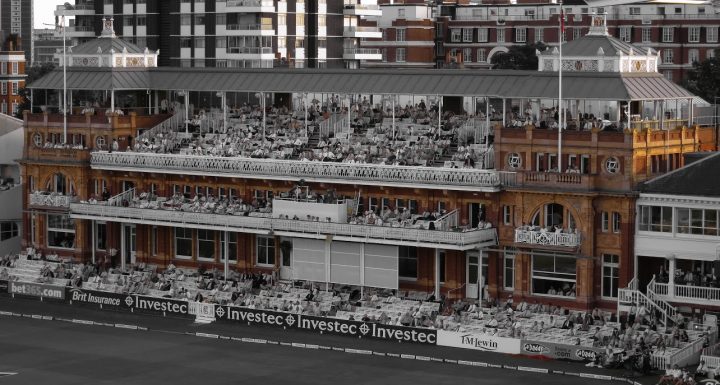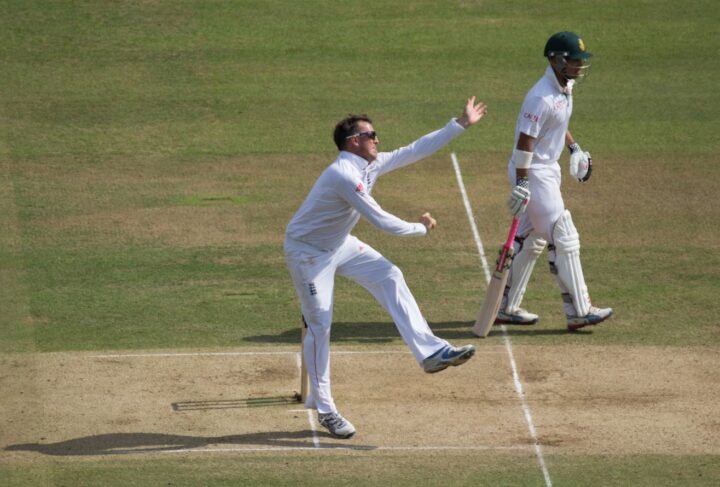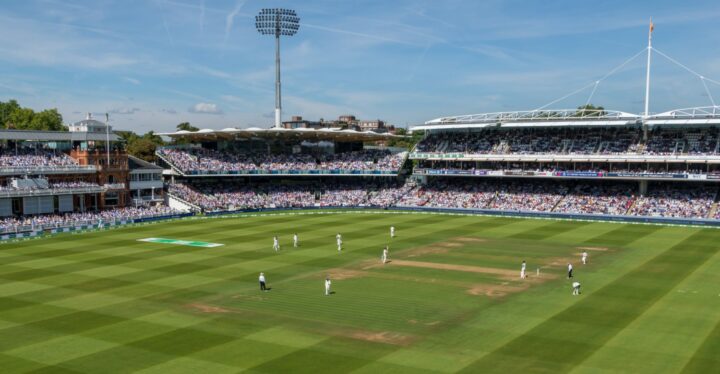With the rain spoiling days 1 and 3 at Lord’s, and a draw looking increasingly likely, now seems like an opportune moment to reignite the DRS debate. Here’s new guest writer Ed Clark with his take on the terrible umpiring at Edgbaston and the future of technology in cricket.
I’m a bit tied up this week so apologies for the lack of daily reports. I’ll do an extended review of the test when it finishes instead. In the meantime, here’s Ed …
The first Ashes test this month was memorable for plenty of reasons. Steve Smith’s twin comeback tons (one of the great sporting regenerations), James Anderson throwing his series future into doubt with a torn calf, and the dramatic turnaround Australia pulled off to win on the final day after being 120-8 on the first. All the thrills and spills of Test cricket which promise for an intriguing series.
Unfortunately, the other major talking point was the standard of umpiring during the match, and in particular the sheer number of incorrect decisions overturned on review. Poor Joel Wilson, a recent addition to the ICC’s elite panel, was under real scrutiny with eight (eight!) overturned decisions.
The trigger was David Warner being caught behind on the first morning off his first ball and not given. That said, he didn’t walk, and the slips didn’t appeal. In his second innings, he was given not out, which was overturned on review. Again, anyone who’s umpired any level of cricket can tell you the dismissal didn’t ‘look right’ (whatever that means), so it seems understandable. But Joe Root was given out four times and overturned each and every decision. By the end, it had become ludicrous – a thick edge onto pad going completely undetected.
In terms of DRS, this match has been coming for a long time. With the current system, it was only a matter of time until a game came up where the decisions were just inaccurate enough to move out of the buffer zone of umpire’s call. A game where a few howlers were missed early on, which caused a bit of a panic to set in amongst the officials. A game where, once the media had picked up on the wrong calls, they would come to dominate discussion.
The ICC has made it clear that it’s got no plans to change the on-field umpires for the series at this stage (and England could probably learn something from this avoidance of a knee-jerk replacement following one bad game). But calls will keep growing for a review of technology’s role in cricket for future series, especially as every game now counts towards the new, nebulous, Test Championship.
For what it’s worth, I believe that, like fire, DRS is a wonderful servant, but a terrible master. If we allow technology to run every facet of the game, then we lose entertainment value through frequent delays and undermine the human instincts and intuitions of trained umpires. At the same time, where technology exists to aid decision-making and weed out any clearly incorrect calls, it seems obstinate not to use it. The main challenge, as almost every pundit and punter’s argument reduces to, is the need for consistency. And ideally, consistently good.
So, what are some feasible new applications of technology that would give us a consistent level of umpiring, minimising errors but not freezing umps out?
Firstly, the logistics of the game. No-balls, for example. The third umpire (or a dedicated new official) can review every delivery for a foot no-ball, help umpires on any height calls, illegal field placings, or recording time a player spent off the field could also be covered. Essentially, it’s taking the ‘everyball’ tasks and having a near-automated approach that doesn’t miss a thing.
Secondly, dismissals. When given out, it makes sense at the highest level of the game to review every dismissal for a clear error, instead of putting that in the hands of the players. With generous ‘umpire’s call’ margins, we should default to most decisions being upheld, which is good for the pace of the game and the integrity of the umpires. It might even be worth considering that 2 out of 3 of the indicators on a catch, for example, (hotspot, snicko, spinvision) have to corroborate to reverse an on-field call. All this should be able to be completed well within the three minutes, set down in the Laws, between a dismissal and the next ball.
Thirdly, player reviews. When given not out, things become trickier. Until DRS develops in terms of speed, it doesn’t seem realistic to review every not-out decision in real time. The VAR-esque approach of allowing play to continue but potentially bringing it back is also challenging as each ball delivered plays a role in changing the face of the game. So keep the two reviews per innings for fielding sides; one possibly beneficial side-effect of reviewing every ‘out’ decision is that umpires will be more confident in tech as a safety net rather than a competitor.
It’s easy to think that cricket umpires have less to do than in sports like football or rugby. However, that would be to underestimate the human skills which are central to the role. Questions abound in cricket which are extremely difficult to answer with technology. Was the batsman playing a shot? Were they taking evasive action? Was the ball dead? Is the fielding side wasting time? Has the bowling become intimidatory? And there are new considerations with every tweak to the rule book, such as ‘fake fielding’ and the yellow/red card system. I’d like to see AI try and send Ben Stokes off the field.
Ultimately, umpiring a cricket match is one of the most demanding roles for any sporting official. It’s difficult, very much so. But when a bad day for the umpire can affect a player’s professional career, we shouldn’t be afraid to turn to technology.
Ed Clark









The phrase ‘Umpires Call’ should be abolished. All those marginal LBW decisions now should simply be not out.
You are missing the point of “uncertainty” or “error”. If the ball-tracking says “umpires call”, it is just as likely that the ball is crashing into the stumps as it is missing. I think the current protocol (including not losing the review on a failed “umpires call”) is the best solution.
I agree with you. It’s nonsense to have a situation where the verdict can be different based on the original decision. There have been enough questionable decisions on the basis of predicted trajectory – which can never, by definition, be resolved definitely. I am perfectly happy with the use of technology to establish facts – pitching out side of leg, for example, – but I would not use it predictively.
There were two more awful decisions today – the “not out” of Head (?) and the “out” of Wade. That’s what DRS is for, but shouldn’t the decisions have been better anyway?
As I have said before, we have 4 umpires for each test so rotate them alternate days, thus relieving the incessant pressure, a they have to concentrate on every ball for 6 hours a day. No player has to do that.
I’m not a fan of VAR in footie, it being a fluid game. Reducing it to stop start every time there’s a bit of controversy quickly gets infuriating. In Rugby it’s even worse as every try seems to be referred, sometimes for an issue that happened well beforehand. Retrospective decisions are an anathema to me. The one thing technology can’t pin down is intent and that is clearly an issue in footie and Rugby where as the referee is in a far better position to give the right decision.
I don’t see how trying to pin things down to almost impossible margins helps any game as a spectacle. It’s noticeable too that VAR and DRS produce almost as much controversy as there was before they started interfering with their respective game’s, like an officious ref constantly blowing up for every minute offence.
Snicko is probably the worst offender as many of the contacts are so tiny as to be beyond the range of the human ear 20 yards away. I don’t think it’s any coincidence that umpiring decisions are now being questioned more on and off the field. I wonder when the likes of Flagg, Constant and Bird were out there would their decisions be any more accurate than today? There is no way of telling, but they would certainly have been questioned more, thus putting more pressure on their reputations with the soft signals and umpires calls. With massive screens showing it all in slow motion from endless angles which the umpires don’t have access to it’s no wonder we’re getting discrepancies with instant decisions made in real time.
We are getting to the point where officials will be made redundant and the game altered so technology can police it. Questionable decisions are part of the fabric of the game that makes for enjoyable discussion and argument. Take the chance factor out and you have an antiseptic ‘entertainment’.
When technology is genuinely able to give decisions live, that’ll be great. Ensures the right call every time. Hate it when someone gets lucky just as much as when you get a stinker.. sadly, the rubbish about it evens itself up just isn’t true.
Umpires at alllevels are dire.. I’d rather have player umpires As at least you know where you stand
Then you must hate the game, because that’s the way its always been. We’re not talking about stinkers here, we’re talking about marginal decisions which are still debatable after technology comes up with an answer. The benefit of the doubt has always been part of the game.
I don’t know how much cricket you’ve actually played but ‘umpires at all levels are dire.. I’d rather have player umpires’ is about as daft a comment as I’ve herd on this blog. The reason you try to have specialist umpires, even at club level, is exactly because players don’t make acceptable umpires. It compromises them straight away and creates a lot of ill will. You need people who are use to dealing with the sights and sounds involved in decision making. Anyway many of the present crew of umpires are ex-players, so you’re getting them anyway. The key to getting lucky is you can’t rely on it, so in that sense it’s no different from someone dropping a catch. I know it doesn’t even itself out but luck has never done that. Things like LBW can never be more than speculation most of the time as it’s only at the top level you get the bonus of slow motion action replays and Snicko to make retrospective decisions.
ive Never played a league game without league umpires and it’s horrible. The amount of bad decisions really is dire. It creates a game where you can’t bat properly for fear of them giving a poor lbw decision (many players move to leg stump guard simply because umpires are that bad)
Player umpires cause issues but st least you know you won’t ger your day ruined (one ball as a batter ruins the day remember).. expensive both in money and time to have someone fire you. Quick way to lose players, more so now than previous years when people tended to accept it but keep turning up .
Getting the right call ball in ball out is where the pro game needs to be, then you get rid of luck in FTA sense. They need to speed it to real time (same with calling no balls etc) and get the accuracy good enough to simply be called out or in.
Then the game would be fine. Umpires can be left behind
How do you know as a batsman, unless you are the non striker, thus giving you pretty much the same view as the umpire, whether any LBW decision is a stinker? The only thing you know is when you get an inside edge and even that can be confused with the bat flicking the pad. We’ve seen in this test unreviewed and even in appealed hits on the pad which technology has shown hitting the stumps. That’s how reliable the players on the field are at judging LBW. It’s always been a notoriously dodgy dismissal. How many players come off the field complaining about it because to them it’s a legitimate excuse an no one can prove otherwise.
The umpire is in the best position to judge this and you need experience to be able to consider the necessary contingencies. Club cricket will never have DRS so you just have to make use of the best available alternative. It’s all part of the game and balanced out for the team by the fact that the balls beaten the bat anyway and you can still get leg byes as a result.
LBW. Used to be if in doubt not out. The batsman gets the benefit. Archers wicket today, the ball hit the knee roll, too high, but the technology decided it would have hit the stumps. Really? At his pace surely it would have gone over. Perhaps someone can explain to me how the technology decided it would have hit? Pace, pitch, bounce, angle?
But that aside, all these constant reviews slow the game down, take the human side out of it and ensures that they rarely bowl 90 overs in a day even with an extra half hour. Personally you either use technology for everything or you don’t use it all, I can’t see at the moment that it’s really helping anyone to any great degree because you still win some or lose some, even with the tech.
Can I refer you back to the two stinkers I mentioned earlier?
They’re only stinkers because technology allowed you to to view them unrealistically. The umpires don’t get that. How many times have you said ‘out’ or ‘not out’ and been proved wrong by slow motion technology? There very few stinkers viewed in real time. Even players who believe they’ve either hit or not hit a ball are often ‘proved’ wrong by snicko, so what chance do we have.
Shouldn’t stats in matches pre DRS be kept separate from todays stats, batsmen getting reprieved with DRS and going on to get scores like Smith in last test when pre DRS he would have been out LBW and same for bowlers getting wickets with DRS.
If the tech gets fast and accurate enough I would be more than happy to have every appeal referred. Has to happen quick though ie less than 15 secs. So it’s automatically calculated the umpire can press a referral button and get an answer within 15 secs. Needs to be some player penalty for appealing eg 1 run for each not out.
Umpires then will become glorified hat stands.
DRS is there to correct major errors by umpires, not to correct close calls that were wrong. Which is why I’m happy with the concept of umpires call on marginal LBWs. I was even happy with sides losing their review in the case of umpires call.
But this only works for LBWs at the moment. For catches there’s no no concept of umpires call. I’d like to see decisions going with the umpires when the bat or glove barely touches the ball. Sides that appeal for catches that are not given in those situations and go for DRS should get the same treatment as when they call in DRs for LBWs that aren’t given and where the ball barely touches the stumps. Batsman not out and (if it was up to me) a review lost for claiming that a marginal call was a big error.
But the danger here is just over complicating the game by largely removing the human element. At the end of the day cricket is entertainment and shouldn’t be constantly interrupted by reviews. You win some and you lose some either way.You can’t have it both ways, and you will not convince me that umpires call is a fair system or that a computer is no more than the weather forecast, in that it takes an “average” view of what may or may not happen.
I like the idea of reviewing every ‘out’ decision, as it ought not to slow proceedings down unduly.
To keep the balance, perhaps then increase the number of fielding side reviews to three ?
Absolutely disgusted by the English crowd booing Smith after he came off injured from the hit to the head off Archer. The guy was obviously playing in pain after an earlier bad knock on the arm, also from Archer. How about some appreciation of the brave innings he was playing..bad one England crowd.
And then to boo again when he came back after concussion testing. Even the television commentary expressed their disappointment at the crowd behaviour.
The only way England can get Smith out is to try and put him in hospital. After nearly 2 Tests the penny eventually dropped that you’ve got to pitch it up to stand any chance. Lots of brains in this England side aren’t there!
That spell from Archer was one of the great spells. Don’t think I’ve seen better in nearly 40 years. To rough up a batsman like Smith, in the form he’s in, was astonishing. And brilliant from Smith too, went up in my and many others’ estimation today I’m sure. How sad (yet typical) that the hooligan element that plagues all cricket matches these days saw fit to boo one of the bravest efforts you’ll ever see.
There should be no such thing as “Umpire’s call” for LBW’s. Where the ball is tracked to clip the stumps it should be out.
1) The morons who booed Smith have absolutely no place on a cricket ground.
2) I detest DRS. It can only be used in a tiny fraction of cricket games, it interrupts the flow of play and is seriously flawed (umpires call among other things). Has umpiring improved as a result of DRS? I think not. I realise this is a minority view but I will not be swayed.
Agree on both points. Umpiring has got worse because the umps can refer to the tech. And throw the morons out. I bet none of them have ever made a mistake in their idiotic lives!
comment from the Australian Cricket Association……. to see the (concussion) protocols practised at Lords overnight was important and correct. What was unwelcome and incorrect was the sound of booing of an injured player. Cricket deserves much better than that. And Lords, the home of cricket, deserves much better than that also. What we witnessed was bravery from an outstanding young man. It should be commended not vilified.”
Well the Root “catch” that wasn’t again shows the problems of technology. It was as clear as day it hit the ground first and yet was given out. Bizarre.
Thanks to Stokes a good days cricket I thought. England were never going to win it because they left the declaration too late for Aussie to go for it, probably not to risk losing. It would have been better if they had been bowled out so more likely of a result.
Ironically the pitch seemed to get lower and slower as the day went on, unless your name was Archer. Also it didn’t turn the way it was expected to and because of the deteriorating light, which was always going to play a part once we had declared, fast bowlers were not an option late on. All this made it difficult to force a result, though if Roy had held on to his catch off Head that would have made it 96-4 and very interesting.
Still I sense we go to Headingly in much better fettle with Butler and Bairstow finding some form with the bat and Bairstow keeping pretty well too. If Smith can’t play and Archer can we must be favourites up there.